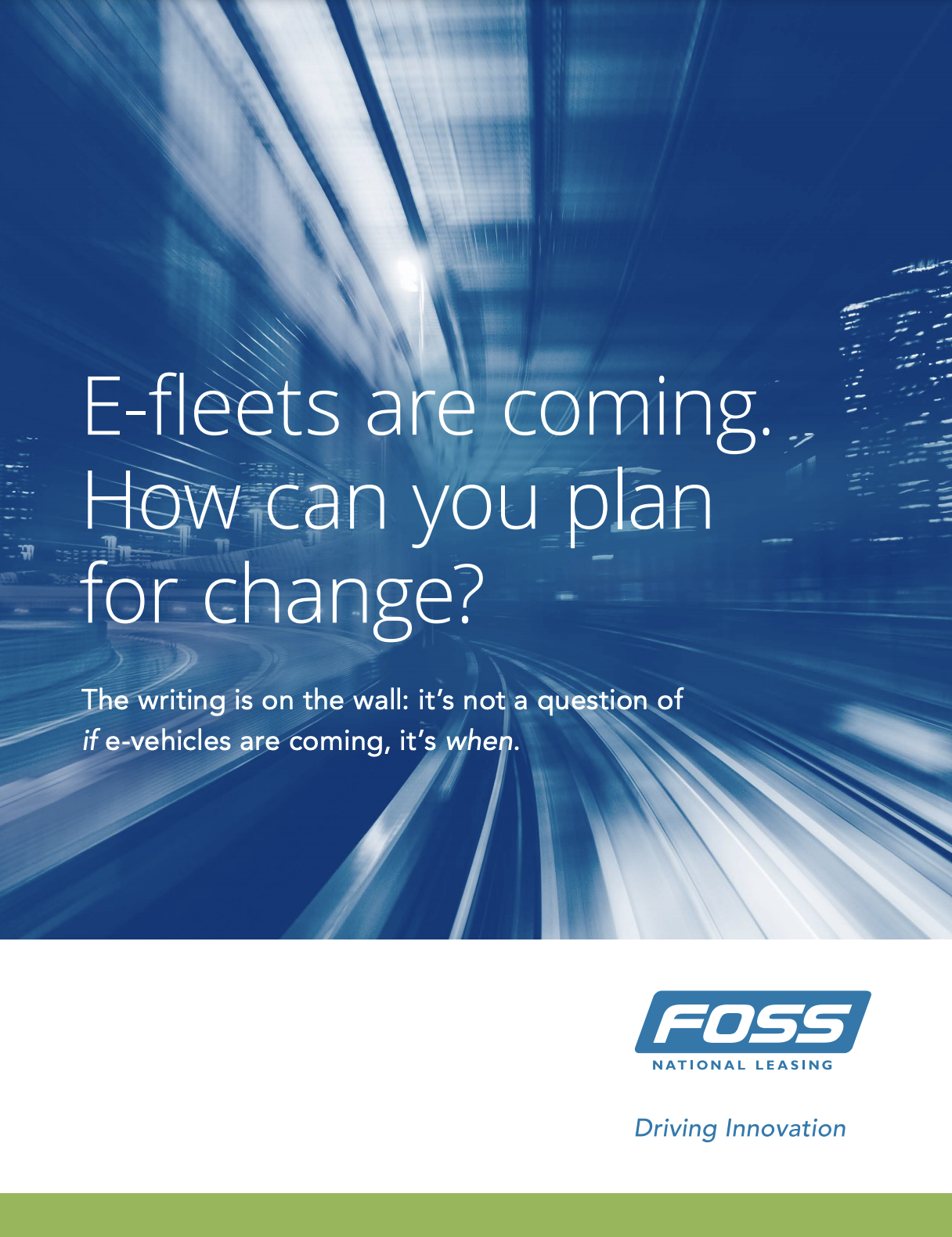
The EV revolution is happening faster than anyone predicted. As a business, you now have the opportunity to position yourself as a technology and sustainability leader by adding electric vehicles to your fleet.
Since EVs are relatively new to the market, this may feel like a big step, especially since you rely on vehicles to keep your business fully operational. There are many aspects you need to consider as your business evolves to introduce this new technology to your world.
There’s a lot of rhetoric about EVs out there. Some of the adoption issues are real, but many of the concerns simply aren’t true. In fact, they may be holding you back from adopting a technology that will ultimately benefit you, your team, and your customers.
Of course, we acknowledge that electric fleet vehicles aren't suitable for every business. But the more information you have, the better decision you'll make whether they're the right choice for you.
To that end, let’s take a look at six common myths around adopting electric vehicles in a fleet management context.
1. EVs aren’t safe enough for my drivers

We know safety is a top concern among fleet managers. So here’s some good news: EV’s have all the standard safety features and must pass the same strict safety standards as conventional vehicles. And they’re passing these standards with flying colours. In fact, the Chevrolet Bolt Four Door Hatchback and the Tesla Model 3 Four Door Sedan both received Top Safety Pick from the Insurance Institute for Highway Safety (IIHS) for 2020.
It can also be argued that gasoline-powered vehicles are more dangerous than EVs because their fuel is explosive. When comparing battery electric vehicles (powered by lithium ion batteries) with gas and diesel-powered ones, a report by the National Highway Traffic Safety Association found that the tendency and severity of explosions from lithium-ion battery systems were comparable or even less than those for conventional vehicles.
Of course, vehicle manufacturers know there are important safety considerations associated with lithium ion batteries, and are making strides in safety as a result. For example, along with insulating battery packs and high-voltage components, OEMs now build in safety switches that disconnect the battery from the power source in the event of a crash.
2. Electric vehicles aren’t really that ‘green’

As EVs become more prominent, critics have raised the concern that they’re not as environmentally friendly as we once thought. Two common issues they name are:
- EVs are often charged with electricity that’s generated from fossil fuels.
- Most EV batteries aren’t recycled, and instead, end up in landfills.
We looked into these concerns, and here’s what we found:
A recent study found that in 95% of the world, switching from a fossil-fuel-powered vehicle to an EV equivalent would lead to overall emissions reductions. This is true even when taking the full lifecycle of the EV into account (the mining of metals, production, and end-of-life disposal), and even in regions where most electricity generation is from fossil fuels.
When it comes to EV battery disposal, we agree that the concern about EV batteries ending up in landfills is valid. The availability of battery recycling solutions definitely needs to improve. But the good news is, there are companies, like Ontario-based Li-Cycle, that are already providing innovative recycling solutions. Companies like this will continue to grow as the demand for electric vehicles increases.
Furthermore, did you know that when an EV battery is depleted, it still retains around 50-70% of its power? This means it can be put to other uses, such as:
- home energy storage.
- powering street lights.
- backing up electrical grids.
- storing renewable energy produced by wind and solar.
This circular approach to EV battery management reduces the resources needed to recycle or otherwise dispose of the batteries.
3. The lifespan of EV batteries is too short to be practical

Many people compare electrical vehicle batteries to smartphone batteries, as both are lithium-ion. We know that smartphone batteries have a lifespan of only a few years. So it can seem logical to assume that EV batteries have a similar trajectory.
But, thankfully that’s not the case.
Electric vehicle batteries come with a manufacturer warranty of eight years or about 160,000 kilometres. This should put to rest any fears of premature degradation. And since regularly reaching a 0% charge is damaging for lithium-ion batteries, EVs also have safeguards in place to prevent their batteries from ever dropping below a 10-15% charge.
Temperature, vehicle usage cycles, driving habits, and cargo load also play an important role in maintaining battery health. So, it’s best to understand how each of these affects your battery so you can prolong its life as much as possible.
To see how real-world conditions influence the health of different electric vehicle batteries, check out Geotab’s EV Battery Degradation Tool.
4. An electric fleet doesn’t make sense for cold weather driving

Canadian fleet drivers definitely don't want to end up stuck out on the road during freezing temperatures. So of course EV winter performance is a real concern. But it’s a fact that all vehicles, including gas and diesel-powered ones, perform less efficiently during cold weather.
In fact, a 100% electric vehicle will actually start more easily than a gas-powered car when cold. This is because EVs have fewer moving parts and don't rely on oil, which can become thick and molasses-like in cold weather.
However, it's true that in cold weather, an EV will need to use more power to keep the battery at its preferred operating temperature. This means the vehicle’s range will be reduced, and there will be less power available for heating and other auxiliary processes. So you’ll need to consider this when evaluating your routes.
(Read more: Winter Driving Tips: How the Right Tires and Tactics Keep Fleets Safe)
5. More public charging is needed for me to consider an EV fleet program

Although public charging may still be sparse in some areas, there are now over 5,000 public charging stations in Canada. 250 of these are Level 3 DC-Quick chargers that will take an EV battery from empty to 80% in 30-45 minutes. Petro Canada, Tesla, Canadian Tire, Electrify Canada, and others have built out extensive networks of public EV chargers, making public charging more available than ever. Additionally, most EVs have on-board GPS systems that can easily point a driver to nearby charging stations.
Based on what’s happening in the UK—where large stations are being built that can rapid-charge 36 vehicles at a time—similar infrastructure is sure to be built in Canada.
And for those areas in which public charging is harder to find?
Companies can install their own private infrastructure, and recharge electric vehicles overnight or when otherwise not in use. Some provinces provide rebates for the installation of EV chargers at workplaces, for example:
- British Columbia and Edmonton, Alberta provide 50% of total install costs of a workplace Level 2 charger, up to $2,000 per charger.
- Quebec provides 50% of total install costs of a workplace Level 2 charger, up to $5,000 per charger.
6. Electric vehicles don’t have enough range to cover my routes

While EVs have been on the road for years now, some people still have concerns about range. For fleets, who are on the road much more than the average person, this concern is even more pronounced.
Fortunately, these fears are unfounded in a large majority of the cases. A study by researchers at MIT showed that 87% of vehicles on the road could be replaced by an EV with no need to charge throughout the day. In other words, range anxiety was simply unwarranted in 87% of cases.
In Canada, most EVs travel 200-400 km on a single charge. This means, depending on your industry and routes, you can swap your conventional fleet vehicles for electric ones without encountering any range issues.
And for those routes that require travel of over 200 kilometres on a single charge, plug-in hybrid vehicles will still help you reduce emissions while ensuring drivers have enough power to get where they need to go, and back. Plug-in hybrids have all-electric driving distances between 20-80 kilometres, with backup gasoline engines or generators for inter-city highway driving.
Service teams could plug-in at the job site and reimburse clients with a rebate program. There are many solutions yet to be implemented as EVs scale—it’s all a matter of finding the best solution for your business.
(Related post: A Fleet Manager's Guide to Electric Vehicle Types)
Final Thoughts
Electric vehicles have evolved significantly since they were first introduced. Many commonly held misconceptions come from a time before the technology became as sophisticated as it is now. The bottom line is, purchasing and owning an EV is now safer, greener, more affordable, and more practical than ever.
Today, electric fleet vehicles are capable of meeting the range, performance, and sustainability requirements of most service businesses across Canada.
Get to Know the Author
John Blakely is one of Foss National Leasing’s Account Manager for the Eastern Region. John has over 25 years of fleet experience, spanning all aspects of the business, including account management, strategic consulting, and operations. John brings experience and a strong commitment to excellence in service for his customers.
Meet our team






